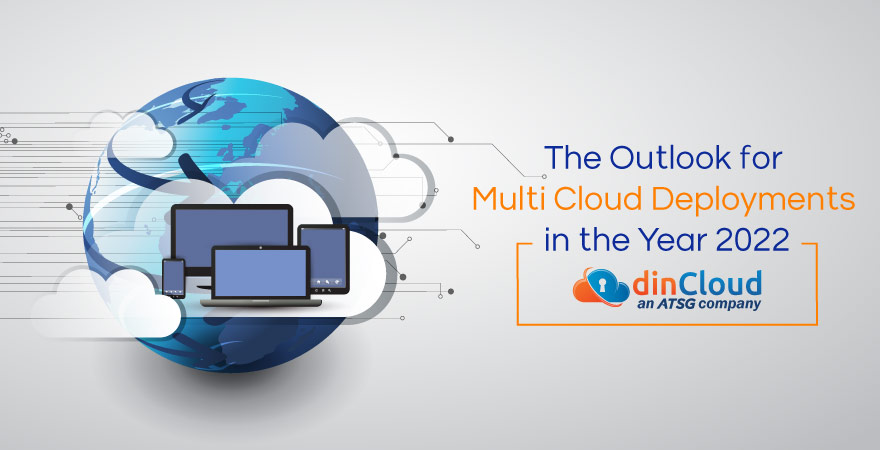With the full onset of the Covid-19 pandemic, enterprises across the globe were thrust into rapid IT infrastructure modernization and digital transformation. Things moved so fast on these two fronts that most organizations were mainly playing “catch-up”.
However, with hasty implementations of remote work platforms, which subsequently morphed into hybrid work settings, cyber security and data privacy were really ignored. Actually, it was more of a race against time, rather than a well thought out plan.
Cyber miscreants from across the globe made full use of the vulnerabilities and security gaps that were left around such hastily implemented “makeshift” arrangements. Secondly, no one had initially thought that this crisis would extend for so long.

What is the Multi Cloud?
As the name suggests, a multi cloud environment is characterized by a single enterprise leveraging multiple forms of cloud services and solutions, sourced from different Cloud Service Providers (CSP) like dinCloud.
Further, a multi cloud environment may also involve a private cloud setting, in conjunction with a Public Cloud Provider like dinCloud. Ever since the full onset of the Covid-19 pandemic, we have seen a massive surge in the demand for multi cloud solutions.
In this post, we will be discussing the future outlook of the multi cloud, and the adoption as well as implementation trends that are in vogue right now. We will also discuss some multi cloud related findings and adoption trends by Nutanix.
The Enterprise Cloud Index (ECI) by Nutanix
Nutanix regularly conducts a study by the name of the Enterprise Cloud Index (ECI), in which the company discusses major cloud adoption trends and implementation models. The latest ECI findings are quite focused around the multi-cloud.
Let us highlight some of the major multi cloud related findings and trends that came to light via the Enterprise Cloud Index by Nutanix.
- Two-thirds, or nearly 64% of the surveyed organizations had clearly laid down plans for implementing multi-cloud environments within the next three years.
- An overwhelming 87% of the respondents declared simpler management as a critical success factor for multi cloud deployments.
- 80% of the respondents cited the re-factoring of legacy applications as a costly and time consuming undertaking when adopting the multi cloud.
- Workload portability, a factor that impacts the success of multi cloud, was cited as a significant multi cloud challenge by 77% of the respondent organizations.
- Interestingly, the majority 72% of respondent IT professionals believed that post pandemic, IT had adopted the role of a much more strategic function.
- A hybrid multi cloud environment was declared as the ideal and optimal deployment model by 83% of the respondents, due to the operational consistencies that follow.
- 61% of the respondents declared flexible productivity environments as key to their success in the post pandemic scenario, and consider the multi cloud an enabler.
Let us briefly touch upon the challenges that multi cloud environments accompany for the deploying enterprises.
Security and Compliance
In any multi cloud environment, complexity is an unavoidable consequence. This complexity of the multi cloud makes both cyber security and regulatory compliance two very pronounced challenges for such deployments.
The infrastructure of each cloud provider, which constitutes a multi cloud, is designed around a different set of cyber security protocols. Then, each cloud provider has its own regulatory compliance posture that any deploying enterprise needs to take into account.
Data Integration
In any multi cloud environment, it is unavoidable that the enterprise data is scattered across different cloud environments. This makes the integration of this data into a cohesive chunk a lot more challenging.
In the case of most multi cloud deployments, data integration challenges will be around. However, the enterprises that are able to manage and mitigate such challenges will be able to derive good value from the multi-cloud.
Deployment and Maintenance Costs
Cost cutting, or cost optimization, is one of the key factors that drives enterprises towards multi cloud environments, despite the additional costs. With the right deployment model and the proper skillset, these costs are well offset by the advantages of the multi cloud.
Conclusion
It is quite easy for us to conclude that the future of the cloud lies in the Multi-Cloud. So, enterprises need to gear themselves up for conceiving, implementing, maintaining and optimizing multi cloud environments.
Contact dinCloud, an ATSG company, for best in class Desktop as a Service (DaaS) and Infrastructure as a Service (IaaS) solutions for your enterprise.


